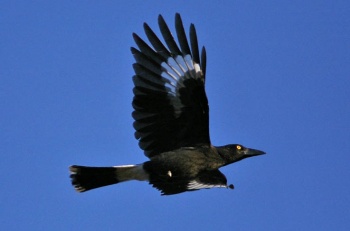Alternative names: Scrub Currawong; Pied Bell-Magpie; Pied Crow-Shrike; Black Magpie; Mountain Magpie
- Strepera graculina
Identification
44 - 50cm (17¼-19¾ in). A large, black passerine:
- Mostly black plumage
- Bright yellow eye
- Small patches of white under tail, the tips and bases of the tail feathers
- Large white patch on wing formed by white bases of primaries
- Large black bill and legs
Sexes similar, though females are greyer and slightly smaller than males. Juveniles are similar but brown.
Distribution
Found in eastern Australia and on Lord Howe Island.
Locally common.
Taxonomy
Forms a superspecies with Black Currawong and is sometimes considered conspecific.
Though crow-like in appearance and habits, it is only distantly related to true crows, instead it belongs to the family Artamidae, together with the closely related Australian Magpie and the butcherbirds.
Subspecies
Six subspecies recognized[1]:
- S. g. magnirostris from eastern Cape York Peninsula south to north Queensland
- S. g. robinsoni in coastal ranges of north Queensland and eastern slopes of Great Dividing Range
- S. g. graculina from eastern Queensland south to western slopes of Great Dividing Range, Blue Mountains and southeast New South Wales
- S. g. nebulosa in southeast New South Wales tablelands and eastern Victoria
- S. g. ashbyi in southern half of western Victoria
- S. g. crissalis on Lord Howe Island and offshore islands
Habitat
Eucalypt forests and woodlands. Also in settled areas, farmland, country towns and green parts of cities.
Behaviour
Diet
Feeds omnivorous: fruit, seeds, insects, small vertebrates (including young birds) or snails.
Forages by gleaning on ground and among foliage for insects and fruit. In winter sometimes in large groups.
Breeding
Breeding season generally from August to December. A solitary and territorial breeder. The female builds a bowl shaped nest of sticks, lined with grasses and other soft material in a tree fork. Lays 3 - 4 eggs. The female incubates the eggs, and the male feeds her. The male also supplies food to the female for the first week after the chicks hatch and she feeds the chicks. Nest parasitism by Channel-billed Cuckoo recorded.
Movements
Movements are not yet well understood.
Vocalisation
The main call is a loud currawong, which gives the bird its name. Other frequent sounds include deep croaks and a wolf whistle.
Recording © by Saxon0192
Melbourne, Victoria, Australia, 15th February 2022
References
- Clements, J. F., T. S. Schulenberg, M. J. Iliff, S. M. Billerman, T. A. Fredericks, J. A. Gerbracht, D. Lepage, B. L. Sullivan, and C. L. Wood. 2021. The eBird/Clements checklist of Birds of the World: v2021. Downloaded from https://www.birds.cornell.edu/clementschecklist/download/
- Del Hoyo, J, A Elliott, and D Christie, eds. 2009. Handbook of the Birds of the World. Volume 14: Bush-shrikes to Old World Sparrows. Barcelona: Lynx Edicions. ISBN 978-8496553507
Recommended Citation
- BirdForum Opus contributors. (2025) Pied Currawong. In: BirdForum, the forum for wild birds and birding. Retrieved 25 April 2025 from https://www.birdforum.net/opus/Pied_Currawong
External Links
GSearch checked for 2020 platform.1






